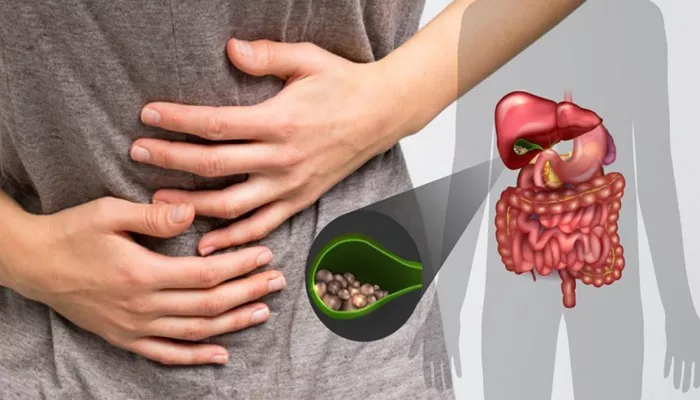Gallstones form when substances in bile crystallize and clump together inside the gallbladder. These hardened deposits range from tiny sand-like grains to large marble-sized stones that can block bile ducts and cause intense pain. Understanding what creates these troublesome stones helps prevent their development and the complications they bring.
The Composition of Gallstones
Cholesterol stones are most common. About 80% of gallstones form when bile contains too much cholesterol and not enough bile salts to keep it dissolved.
Pigment stones come from bilirubin. These darker, smaller stones develop when the liver produces excess bilirubin, often due to blood disorders or liver cirrhosis.
Mixed stones combine both types. Many gallstones contain layers of cholesterol and bilirubin along with calcium salts and other bile components.
Calcium carbonate stones are rare. These unusual stones form when calcium binds with other compounds in abnormal ways.
How Bile Chemistry Creates Stones
Bile becomes oversaturated with cholesterol. When the liver secretes more cholesterol than bile salts can dissolve, crystals begin forming.
Nucleation sites start the process. Tiny particles like calcium salts or shed gallbladder cells provide surfaces for cholesterol crystals to accumulate.
Gallbladder motility affects stone growth. A sluggish gallbladder that doesn’t empty properly allows more time for crystals to clump together.
Bile salt deficiency promotes stones. Insufficient bile salts fail to keep cholesterol suspended in liquid solution.
Risk Factors for Cholesterol Stones
Obesity dramatically increases risk. Excess body fat alters cholesterol metabolism, making bile more prone to stone formation.
Rapid weight loss triggers stones. Losing more than 3 pounds weekly causes the liver to secrete extra cholesterol into bile.
High-fat diets contribute. Frequent consumption of saturated and trans fats increases cholesterol saturation in bile.
Estrogen effects matter. Pregnancy, birth control pills, and hormone therapy all raise cholesterol levels in bile.
Causes of Pigment Stones
Hemolytic anemia produces excess bilirubin. Conditions that destroy red blood cells rapidly overload the liver with hemoglobin breakdown products.
Liver cirrhosis alters bile composition. Scarred livers process bilirubin less efficiently, allowing it to concentrate in the gallbladder.
Infections can initiate stone formation. Certain bacterial infections in bile ducts promote pigment stone development.
Parasites sometimes trigger stones. In some developing countries, liver fluke infections lead to pigment gallstones.
Genetic and Demographic Influences
Native Americans have highest risk. Certain genetic variants in this population predispose to cholesterol supersaturation in bile.
Family history increases susceptibility. Having a first-degree relative with gallstones nearly doubles an individual’s risk.
Women develop stones more often. Hormonal differences and pregnancy effects make women twice as likely as men to form gallstones.
Age plays a significant role. People over 40 produce more cholesterol in bile and have slower gallbladder emptying.
Medical Conditions That Promote Stones
Diabetes accelerates stone formation. Insulin resistance alters cholesterol metabolism and gallbladder function.
Crohn’s disease affects bile absorption. Impaired reabsorption of bile salts in the ileum leads to deficiency.
Gastric bypass surgery changes digestion. Rapid weight loss and altered anatomy combine to increase gallstone risk.
Prolonged fasting slows gallbladder emptying. Extended periods without food allow bile to stagnate and concentrate.
Medications Linked to Gallstones
Cholesterol-lowering drugs sometimes backfire. Fibrates that lower blood cholesterol paradoxically increase cholesterol secretion into bile.
Hormone therapies have effects. Estrogen supplements and certain fertility treatments mimic pregnancy’s gallstone risks.
Octreotide promotes stones. This somatostatin analog used for acromegaly and other conditions dramatically slows gallbladder emptying.
Ceftriaxone antibiotics form sludge. This medication can precipitate in bile as calcium salts that nucleate stones.
Dietary Contributors
Low-fiber diets may play a role. Insoluble fiber helps bind bile salts for excretion, forcing the liver to make fresh bile.
Refined carbohydrates affect metabolism. High sugar intake correlates with increased gallstone formation in some studies.
Irregular eating patterns matter. Skipping meals allows bile to sit stagnant in the gallbladder for prolonged periods.
Dehydration concentrates bile. Inadequate water intake leads to thicker bile more prone to crystallization.
The Stone Formation Process
Phase 1 begins with cholesterol supersaturation. Bile becomes overloaded with cholesterol that exceeds its carrying capacity.
Micelles become unstable. These microscopic bile salt-cholesterol complexes break apart, releasing free cholesterol crystals.
Nucleation starts crystal growth. Tiny particles in bile provide surfaces for cholesterol molecules to arrange into solid structures.
Stone enlargement occurs gradually. Over months or years, layers of cholesterol, bilirubin, and calcium accumulate into visible stones.
Why Some People Form Stones and Others Don’t
Gallbladder motility varies. People with efficient, frequent gallbladder emptying are less likely to develop stones despite similar bile chemistry.
Intestinal bacteria differ. Certain gut microbes process bile salts in ways that either promote or prevent stone formation.
Gallbladder shape affects stasis. Anatomical variations that create pockets or folds encourage bile stagnation where stones can grow.
Mucin production matters. Excess gallbladder mucus provides a matrix that accelerates cholesterol crystal aggregation.
Prevention Strategies
Gradual weight loss is crucial. Losing 1-2 pounds weekly minimizes the liver’s cholesterol secretion spike.
Regular meals maintain motility. Eating at consistent intervals keeps bile moving rather than sitting stagnant.
Healthy fats support bile flow. Moderate amounts of unsaturated fats stimulate gallbladder contraction without overloading bile with cholesterol.
Hydration dilutes bile. Drinking adequate water prevents excessive concentration of bile components.
Conclusion
Gallstones arise from complex interactions between bile chemistry, gallbladder function, and genetic predisposition. Cholesterol imbalance, bile salt deficiency, and sluggish gallbladder emptying create the perfect environment for crystals to form and grow. While some risk factors like age, gender, and genetics can’t be changed, understanding modifiable contributors such as diet, weight management, and medication use empowers people to reduce their gallstone risk significantly. Recognizing early warning signs of developing stones allows for lifestyle adjustments that may prevent painful attacks and dangerous complications. Modern medicine continues to refine our knowledge of gallstone formation, leading to better prevention strategies and treatments for this common yet potentially serious condition.
Related topics:
What Do Gallstones Feel Like In A Woman?
What Are The Side Effects Of Divigel?
Study Reveals Overweight Older Women Face Greater Disability Risks Due To Weaker Legs


